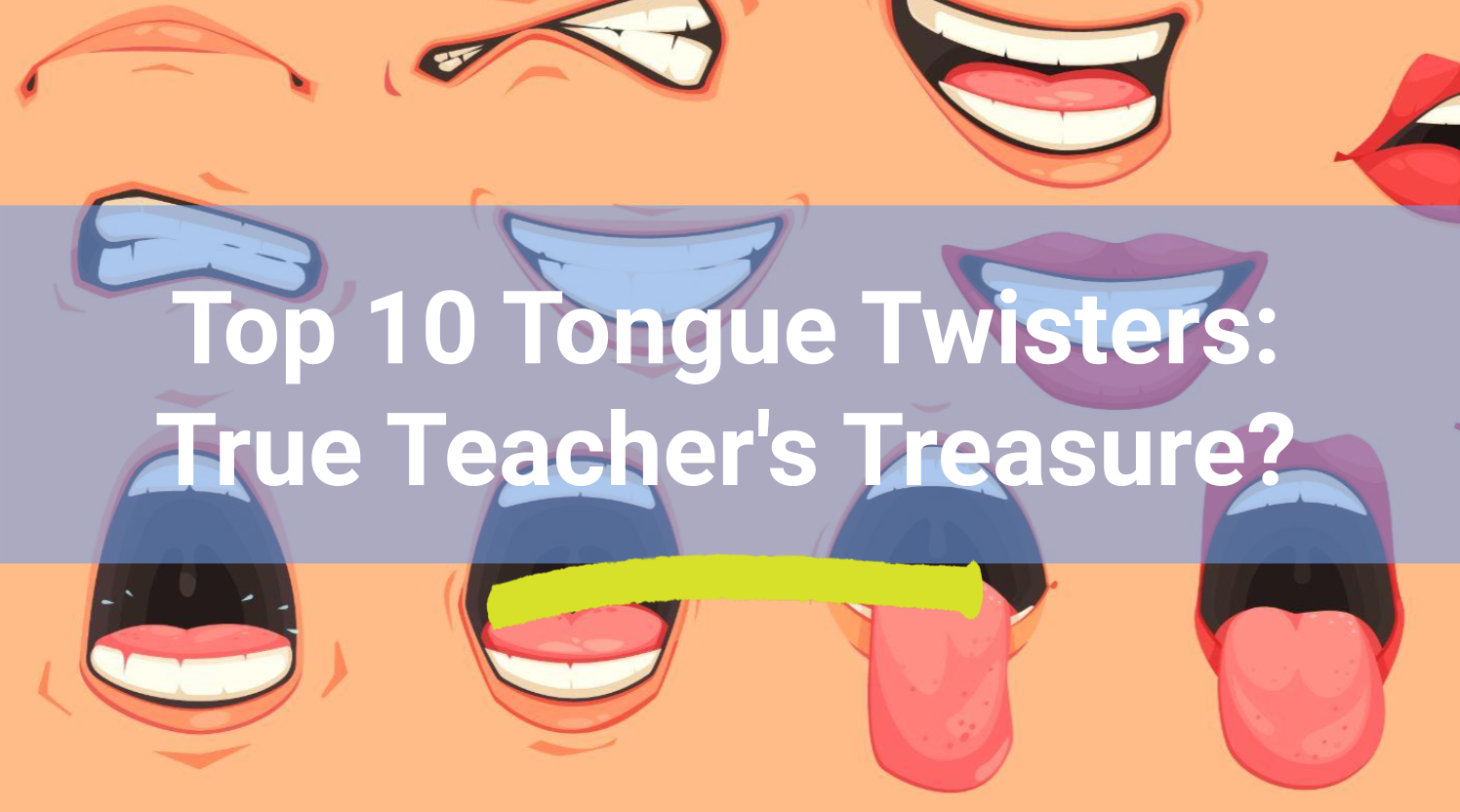Tongue twisters in the ESL classroom – yes or no?

Tongue twisters are a mouthful! They're phrases or sentences that are difficult to say quickly because your tongue literally gets in a jam. They might not make a lot of sense, and are usually very silly, but along with the fun and giggles, tongue twisters are a powerful tool for improving pronunciation skills and fluency. As if that weren't enough to gain, the alliteration that often accompanies tongue twisters are great for improving accents through repetition of sounds.
Here are some common examples of English tongue twisters:
- Peter Piper picked a peck of pickled peppers
- Betty Botter bought some butter
- How much wood would a woodchuck chuck if a woodchuck could chuck wood?
- She sells sea shells by the seashore
- I scream, you scream, we all scream for ice cream!
And here are some fun tongue twister questions:
- Can you can a can as a canner can can a can?
- Does a pessemistic pest exists amidst us?
- How much wood would a woodchuck chuck?
- Which witch switched the Swiss wristwatches?
- How many pickled peppers did Peter Piper pick?
We'll dive into those in more detail below. So, without further adeau, let's spice things up a bit and inject a dose of silliness into the classroom. Try using some of these classic tongue twisters combined with our useful suggestions for teaching.
Classic Tongue Twisters
-
1
Peter Piper
Peter Piper picked a peck of pickled peppers. Did Peter Piper pick a peck of pickled peppers? If Peter Piper picked a peck of pickled peppers, where's the peck of pickled peppers Peter Piper picked? -
2
Woodchuck
How much wood would a woodchuck chuck if a woodchuck could chuck wood? He would chuck, he would, as much as he could, and chuck as much wood as a woodchuck would if a woodchuck could chuck wood. -
3
Seashells
She sells seashells on the seashore. The shells she sells are surely seashells. So if she sells shells on the seashore, I'm sure she sells seashore shells.Easy Tongue Twisters
-
4
Shoeshine Shop
I saw Suzie sitting in a shoeshine shop. -
5
Can you can a can?
Can you can a can as a canner can can a can. -
6
Tom Threw Thumbtacks
Tom threw Tim three thumbtacks.Medium Tongue Twisters
-
7
Fuzzy Wuzzy
Fuzzy Wuzzy was a bear. Fuzzy Wuzzy had no hair. Fuzzy Wuzzy wasn't very fuzzy, was he? -
8
Unique New York
You know New York, you need New York, you know you need unique New York. -
9
I have got a date
I have got a date at a quarter to eight; I’ll see you at the gate, so don’t be late. -
q
Two witches, two watches
If two witches would watch two watches, which witch would watch which watch?Difficult Tongue Twisters
-
w
Betty Botter
Betty Botter had some butter, “But,” she said, “this butter's bitter. If I bake this bitter butter, it would make my batter bitter. But a bit of better butter – that would make my batter better.”
So she bought a bit of butter, better than her bitter butter, and she baked it in her batter, and the batter was not bitter. So 'twas better Betty Botter bought a bit of better butter. -
e
Doctor doctoring
When a doctor doctors a doctor, does the doctor doing the doctoring doctor as the doctor being doctored wants to be doctored or does the doctor doing the doctoring doctor as he wants to doctor? -
r
Swiss wristwatches
Which wristwatches are Swiss wristwatches? I wish to wash my Irish wristwatch.
Tongue Twisters Teaching Tips
- The first thing you’ll need to consider is your students. Tongue twisters are not just for children, but adults too! The main thing to consider are ability levels - beginners and very young ESL learners can learn to say short tongue twisters such as, “I scream for ice cream!” Longer tongue twisters, such as "Peter Piper" can be shortened to a smaller bite size. As another example, the long "Woodchuck" tongue twister can be shortened to just the first question. You know your students better than anyone else, so choose the right tongue twisters for your class.
- Choose a tongue twister with teaching potential. For example, “Peter Piper” is a great tongue twister if you want your students to practice the pronunciation of -ed endings (past form of regular verbs). “Betty Botter” has lots of great consonant sounds like the “b” sound. “I have got a date" is filled with words with the same vowel sound.

How To Proceed
-
1
Hand out copies of the tongue twister to your students and have them read it to themselves.
-
2
Discuss any words they may not be familiar with, like “batter” in Betty Botter. Make sure they understand what the tongue twister is trying to say; there’s usually a logic to what initially seems to be a random jumble of words.
-
3
Ask a student to read it out loud, but don’t make any corrections. Make a note of the problem areas. Do the same with the rest of the students in the class. Have them take turns reading the tongue twister, and you’ll see which have greater difficulties.
-
4
Read each line or section, one at a time, and ask students to repeat after you. You may wish to do this with one student only, small groups, or the entire class, but this is a great opportunity to work especially with students who have pronunciation difficulties.
-
5
Focus on specific consonant or vowel sounds. This is a great time to practice sounds like the “t” sound in “better”, “batter”, and “bitter”.
-
6
For extended practice, ask students to come up with more examples of homophones, like “which” and “witch”; or more words that sound like “date”, other than the ones included in the tongue twister; you may also choose to focus on the different pronunciations of the past form of regular verbs.
And don’t forget to have fun with them!
Try to read the tongue twister as fast as you can. Your students will be pleased to know that even YOU may get tongue tied! Or they may be very impressed as you roll one off your tongue perfectly. But remember that tongue twisters are not only fun - there are plenty of pronunciation lessons held within each and every one.
What do you think about our top ten tongue twisters? If you’re looking for even more good ones to use in class be sure to check out our Tongue Twisters Worksheets, where you’ll find plenty to choose from. What's your personal favorite?
P.S. If you enjoyed this article, please help spread it by clicking one of those sharing buttons below. And if you are interested in more, you should follow our Facebook page where we share more about creative, non-boring ways to teach English.







